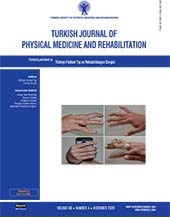Clinical and radiological outcomes of kinesiotaping in patients with chronic neck pain: A double-blinded, randomized, placebo-controlled study
2 Department of Radiology, University of Health Sciences, Fatih Sultan Mehmet Training and Research Hospital, Istanbul, Turkey
3 Department of Physical Medicine and Rehabilitation, University of Health Sciences, Haydarpaşa Numune Training and Research Hospital, Istanbul, Turkey DOI : 10.5606/tftrd.2020.5632 Objectives: In this study, we aimed to evaluate the efficacy of kinesiotaping (KT) in patients with chronic non-specific neck pain (NSNP) in terms of pain, disability, cervical range of motion (ROM), and cervical lordosis.
Patients and methods: Between October 2013 and March 2014, a total of 50 patients (10 males, 40 females; mean age 35.1±9.9 years; range, 17 to 62 years) with chronic NSNP were randomized into the KT (n=25) or the sham KT intervention (n=25) groups. Both groups were additionally given a therapeutic exercise (TE) program. The Visual Analog Scale (VAS) and Neck Disability Index (NDI) scores and ROM measurements were recorded at baseline, at the end of treatment, and at one month. Lateral cervical digital radiographs were analyzed by the Cobb, posterior tangent and effective lordosis methods at baseline and at one month after the treatment.
Results: There was a statistically significant decrease in the VAS scores compared to baseline in the KT group. The NDI scores significantly decreased in both groups. The patients in the KT group experienced a significant increase in all planes of cervical ROM after the treatment. Cervical radiographs revealed a significant increase in the Cobb and posterior tangent angles only in the KT group.
Conclusion: Our study results suggest that KT significantly improves VAS, NDI scores, ROM and cervical lordosis angles. The combination of TE and KT is useful in reducing pain and disability and improving ROM and cervical lordosis loss in patients with chronic NSNP.
Keywords : Cervical lordosis, kinesiotaping, neck pain

















